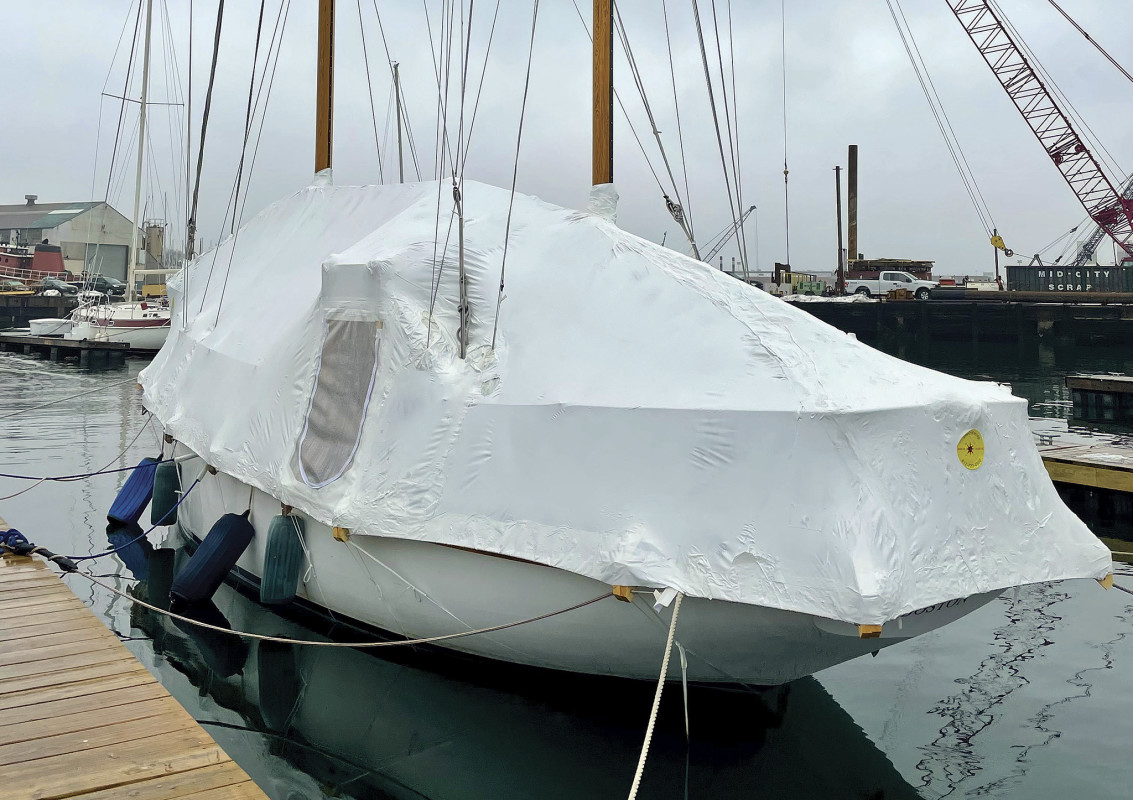
One of the best winter storage location on your boat is a sunny, tropical place with palm bushes swaying on the shore, turquoise water gurgling in her bow wave, and also you ensconced on the helm. But when your boat lives the place winter delivers ice and snow, and if crusing south to keep away from the weather isn’t an possibility, then the boat have to be put to mattress for the darkish and chilly a part of the 12 months as a substitute.
Selecting a perfect spot for her hibernation deserves cautious consideration. Stowing your boat on a trailer or stands in your yard could be an apparent alternative in case your boat and yard allow. If not, choices break down into two basic classes: in-water marina storage, and on-land boatyard storage. There isn’t any straightforward or best option right here. Each choices are often viable, and each supply distinct benefits and dangers.
In-Water Storage
The mixture of water salinity and tidal currents retains many northern harbors ice-free all winter, even in a lot of chilly northern New England the place the larger tides compensate for the colder temperatures properly. In-water boat storage is just not suggested in ice-prone lakes, rivers, and brackish harbors. Bubblers can preserve water open in locations like this, however an influence outage or a damaged bubbler can depart your boat at excessive danger from ice harm throughout a chilly snap.
In locations the place moist storage is an possibility, this alternative has many benefits. The boat is supported extra evenly within the water than she is on the stress factors of blocks and stands ashore. This uniform help will forestall unintended hundreds on standing rigging, bulkheads, and cabinetry whereas additionally permitting the keel to hold all 12 months lengthy, decreasing the possibility of a keel-smile and related keel issues from growing.

Photograph: Christopher Birch
Sarcastically, your boat stays drier in moist storage. The seawater she sits in retains the boat cooler in the course of the day and hotter at night time. Decreasing the every day temperature swing reduces condensation aboard. Comparatively dry situations are even maintained beneath water; small moisture pockets contained in the rudder gained’t freeze if the rudder stays submerged in saltwater. The growth attributable to such a freeze is what opens microscopic cracks within the rudder, permitting extra corrosive water in, a cycle that can finally result in rudder failure. Retaining your boat’s rudder within the water all winter will assist preserve its innards dry, corrosion-free, and powerful.
Winter initiatives typically go extra easily on a ship floating in a marina slip. Electrical energy will often be extra conveniently accessed in a slip than from a distant, overloaded energy put up within the boatyard. Boarding your boat in a marina requires no ladder, and her cabin and decks will keep cleaner when those that work on her within the winter aren’t climbing aboard with boots lined in boatyard mud.
That stated, when you gained’t want to fret a couple of fall from a ladder when engaged on a floating boat, you in all probability must take care of slippery, icy docks at one level or one other, and a fall into the water at the moment of 12 months could be lethal. So it’s necessary to maintain your wits about you on the docks and when boarding and leaving; and equally necessary to let somebody—such because the marina workers—know the place you might be and what you’re doing.
Moist storage clears your boat from the chance of a storm-felled tree or a domino- model boat row collapse on the onerous. It additionally clears you from the chance of misplaced crusing days. When your boat is saved in water, you’ll be in full management of the winterization and commissioning dates and be capable of lengthen the crusing season on both finish as a lot or as little as you need. You gained’t be on the entrance of a stack of boats within the yard and pressured to splash early within the spring. And also you gained’t be caught at the back of the stack of boats and compelled to attend until early summer season earlier than your boat will get launched.
Picket boats positively profit from wintering over in water the place they gained’t dry out and open up seams beneath the waterline. With the identical basic premise utilized in reverse, I’ve heard individuals declare their fiberglass boat wants to return out of the water within the winter to dry out after absorbing water all summer season. That’s a delusion to be ignored. Fiberglass boats in good well being don’t absorb water all summer season and so they don’t must dry out.
Should you do determine to go along with moist winter storage on your boat, select a marina with 360-degree safety from evermore highly effective winter climate. Doubling up dock traces and including chafe gear is important for this season.

Photograph: Christopher Birch
On-Land Storage
To a big diploma, your winter work checklist could dictate your alternative. It’s price noting that backside portray goes extra easily when the boat is out of the water, not in it. Different near- or below-the-waterline initiatives like portray the boot stripe or changing a seacock or cutlass bearing may even require the boat to be on the onerous. Some winters it’s good to have entry to all the boat, not simply above the waterline.
A ship saved in water outfitted with a great winter cowl, and fortified by correct winterization, has the identical danger of growing a seawater leak within the winter as she does in the summertime. It is a danger you may handle however can not ignore fully. Stuffing containers can weep in all seasons. Boats can break away from their mooring traces and collide catastrophically with each other or the shoreline in any month. A ship saved on land won’t develop a seawater leak and won’t find yourself submerged on the underside of the harbor.
That stated, sinking is a priority to concentrate on regardless of the place you retailer your boat. An insurance coverage individual as soon as instructed me that extra boats “sink” on land yearly than within the water. Rain and snow can discover their manner into the cabin from a deck leak or a failed scupper hose or hatch. Condensation and rainwater coming into by way of openings within the mast will compound the issue. The ensuing freshwater flooding from above could cause simply as a lot harm as can the ingress of seawater from beneath. Sailors are inclined to turn out to be complacent concerning the sinking danger for a ship saved on land, and that may be a mistake.

Photograph: Christopher Birch
A high-quality, well-fitted cowl will assist to reduce danger for boats saved each out and in of the water. It is usually essential to keep up the performance of the bilge pumps all through the winter. Correct winterization of the bilge, bilge pumps, and related pump hoses with non-toxic antifreeze will forestall ice-up. To take care of the auto operate of your electrical bilge pumps, the boat batteries ought to keep aboard for the winter and have to be saved charged. A photo voltaic panel can handle this job when an alternate supply of charging energy is just not handy. The necessity to take away batteries from boats in winter is an previous wive’s story to be ignored. So long as they’re saved charged, your boat batteries will do exactly fantastic in your boat all winter similar to your automotive battery does simply fantastic in your automotive all winter.
Common inspections are key regardless of the place the boat winters over. If the quilt turns into compromised, it’ll want restore. If sufficient rainwater makes its manner down the within of the mast on a ship with a keel-stepped rig, she could must be pumped out and have her bilge and bilge pumps re-flushed with non-toxic antifreeze a number of occasions in the course of the low season. For boats saved on land, jack-stands must be checked to verify they haven’t shifted or sunk into the mud and turn out to be unfastened. For boats wintering within the water, dock traces and fenders must be usually inspected for put on.
Moist storage often prices lower than dry storage. However there are extra prices to contemplate. The boat that winters within the water will want a diver to clean the underside and alter zincs within the spring. And although you gained’t be paying on-land storage costs, you’ll nonetheless must pay for haul-out charges to tune up your backside paint and do different under-the-waterline upkeep. Put on and tear on fenders, fender covers, and dock traces is a hidden and important price related to in-water storage to concentrate on. When all bills are added up, I count on the price might be about the identical both manner.
Finally, the selection comes right down to what initiatives are in your winter work checklist and which dangers you’re extra snug shouldering. Each in-water and on-land could be a sensible choice for winter boat storage. However in some unspecified time in the future, don’t neglect to take a look at the third possibility and sail south—that’s your finest workaround!

October 2024
Trending Merchandise
[product_category category=”trending” per_page=”8″ columns=”2″ orderby=”date” order=”desc”].
